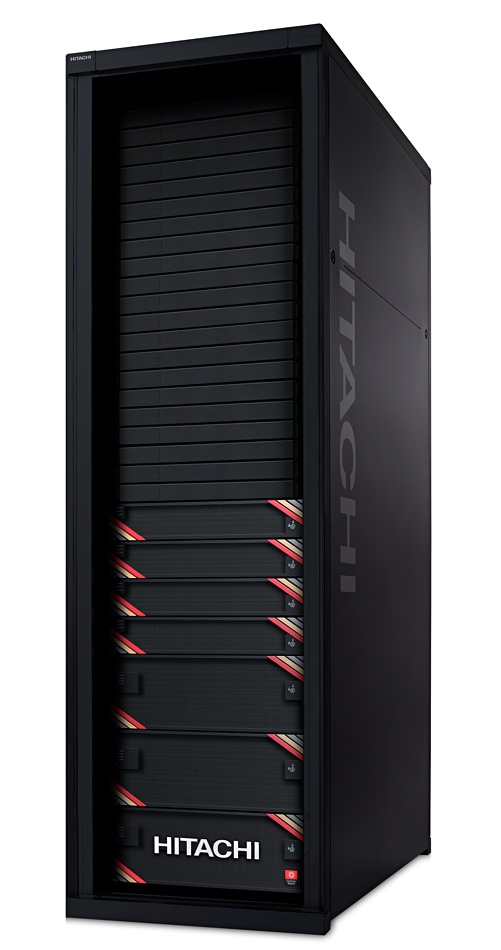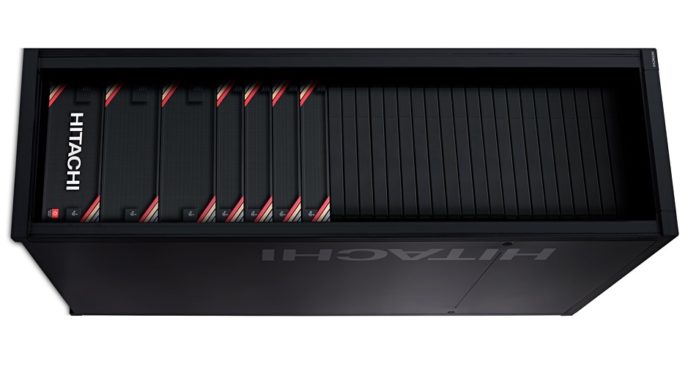Hitachi Vantara has announced a new mid-range array, block storage software for x86 servers and cloud-native apps, placement of its arrays in Equinix colocation centres with high-speed links to public clouds, AI-driven management from the cloud, a hyperconverged storage offering, and a Commvault data protection facility. Phew!
Update. E1090 product details added to table and E1090 replaces the E990 – 24 February 2022.
Update. E1090 is an all-flash array. E1090H is the hybrid flash/disk version. VSS Block only supported in VMware environments with KVM and bare metal server support coming. E1090H product details added to table – 27 February 2022.
There’s a hybrid cloud and embrace-the-public-cloud angle to this and, with regard to the Equinix colo presence, Hitachi Vantara is following a lead set first by NetApp and then by Pure Storage.
Mark Ablett, president of Digital Infrastructure at Hitachi Vantara, set the context with a buzzword-laden statement: “We are accelerating the pace of delivering new hybrid cloud products and services to enable our customers to find innovative ways to enhance their data-driven outcomes today, and in the near future.”
Hitachi Vantara is announcing:
- VSP E1090 with virtual storage scale out capabilities
- Virtual Storage Software Block (VSS Block), a software-defined data platform that extends Hitachi Vantara’s virtual storage platform to cloud-native applications
- Hitachi Ops Center Clear Sight, an AI-driven cloud management tool to support VSP storage with simplified cloud-based reporting and analytics
- Hitachi Cloud Connect (Hitachi V storage in Equinix colos) to deliver a near-cloud system integrating with the big 3 public clouds by extending a data fabric to cloud apps running on them
- Unified Compute Platform RS, a hyperconverged “cloud in a box” offering
- A cloud data protection appliance using Commvault SW to protect data in hybrid cloud operating model
VSP E1090 array
Hitachi Vantara rack-level storage arrays are organised into Virtual Storage Platform (VSP) products with the VSP 5000 high-end NVMe flash array, E Series NVMe SSDs and disk mid-range array, F-Series all-flash enterprise to mid-size array, and G Series flash and disk entry-level array, all running the Storage Virtualisation Operating System SVOS RF.
The VSP E1090 is the new high-end member of the E Series family and tops out the E5900, E790, and E990 product line.
We have built an E Series product table listing controller, capacity and port parameters, with the E1090 highlights being that it has the lowest E Series latency at 41μs and the highest IOPS at 8.4 million:


Both suggest it has had a major controller CPU upgrade. A look at the E1090 rack cabinet shows us three large (4RU) chassis, like the E990, and four small (2RU) chassis. That indicates the E1090 is an upgraded E990. Hitachi Vantara confirmed that the E990 has been discontinued and replaced with the E1090.
A spokesperson told us: “The E1090 comes with either NVMe or SAS (SSD and/or HDD) backend media. Hitachi Vantara is not offering the proprietary FMD on this platform; it is all commodity media. We are not doing drive level compression/dedupe — the hardware offload is the same Compression Accelerator Module that we introduced on the 5200/5600. It is an ASIC-based offload in the controller, so common offload for NVMe and SAS media. We do not offer an QLC drive at this point.”
Update: The E1090 is the all-flash version with an E1090H supporting disks and SAS SSDs as well, like the other models in the range. The O/S provides automated dynamic tiering. There is HW-assisted compression and also O/S software compression and deduplication.
Software and management
New E Series SVOS RF software enables clustering of up to 65 nodes and 130 controllers with Hitachi Ops Center presenting them as a single virtual system to hosts, with federated management, data mobility, data protection, and automation across all the cluster nodes, which can include virtualized third-party arrays – a long-standing SVOS capability.
It also helps provide a self-install capability, non-disruptive data-in-place migration. Hitachi Replication Plug-in for Containers automates storage replication between Kubernetes clusters and storage systems located at different sites, also enabling a self-service approach. Data reduction has been improved with hardware assist providing up to 82 per cent adaptive data reduction throughput improvement over the existing VSP E series. Selectable inline compression and deduplication can be set at the volume level.
VSP Storage Management has analytics and automation across clusters. An embedded management feature provides rapid setup and provisioning of E Series arrays without any additional software installation. The E Series are now self-installable and can be up and running in 30 minutes or less.
Hitachi Vantara has also announced Ops Center Clear Sight, a cloud-based and AI-driven app for monitoring assets from anywhere. Admins can observe, analyse, and optimise VSP storage infrastructure remotely. AI-driven insights provide inventory asset views, health status, risk management, and capacity planning. There is a clear link possible here to AIOps facilities with Hitachi Ops Center ready for Google Anthos. We think Hitachi Vantara’s capability is generally similar in scope to Dell’s CloudIQ.
Inside Ops Center we find Hitachi Remote Ops, with Hitachi Vantara claiming it can resolve up to 90 per cent of support issues using predictive analysis.
VSS Block and erasure coding
The VSS Block software is layered on top of SVOS and presents a single data plane across Hitachi Vantara’s mid-range, enterprise (VSP 5000), and software-defined storage portfolio. It incorporates Hitachi Vantara’s Polyphase Erasure Coding technology. This is based on two patents, US# 10,185,624 B2 and 10,496,479 B2.
A July 2021 Hitachi Vantara blog stated: “Current implementations of erasure coding are fraught with high CPU resource consumption, network latency due to the distributed I/O, and subpar read and write performance due to the same distributed architecture. There is plenty of evidence that pins erasure coding technology to an archival solution, like object storage or write once, read many (WORM) architectures.
“Hitachi’s Polyphase Erasure Coding features a different approach in how it adapts software data protection. Hitachi carefully evaluated erasure coding through years of research and developed a unique patented approach (US# 10,185,624 B2 and 10,496,479 B2). This approach improved crucial elements of data and parity placement, which efficiently improved latency within Hitachi Polyphase Erasure Coding and lowered storage resource overhead. These necessary enhancements provide a place where your data can be synthesized so you can create more value.”
VSS Block supports up to 3.8PB of capacity. It will, in the future, connect to the near-cloud offerings and, ultimately, extend into the public cloud. This means, we understand, that VSS Block will eventually run in AWS, Azure, and GCP.
Update. Also, at launch, VSS Block only supports VMware with support for KVM and bare metal servers expected later in 2022.
Other news
Hitachi Vantara’s Unified Compute Platform (UCP) family of converged and hyperconverged systems now provides so-called “cloud-in-a-box” functionality. A UCP RS system runs VMware Cloud Foundation with VMware Tanzu, which provides combined virtual machine and Kubernetes container app support.
The company’s converged system, Hitachi Adaptive Solution, built with Cisco switching and UCS servers, includes the new E Series storage and Cisco’s UCS X-Series Compute, managed through Cisco’s Intersight hybrid cloud operations platform.
The EverFlex purchase/lease/consumption utility/consumption-as-a-service portfolio has a new member: Hitachi Infrastructure Orchestration as a Service, a data storage management and automation facility. Hitachi says it enhances traditional operations with ML, AI, business process management, integration, and IT process automation software and services to provide continuous insights and intelligence about IT environments. The idea is to facilitate the development of adaptable and autonomous, “self-driving” IT operations.
A new Commvault HyperScale X for Hitachi Data Protection Suite delivers comprehensive data protection across applications, databases, public cloud environments, hypervisors, operating systems, and storage arrays from a single, extensible platform. HyperScale X is a Commvault appliance providing scale-out backup and recovery for container, virtual, and database workloads. There are more than 1,200 joint Hitachi Vantara – Commvault customers.
All in all Hitachi Vantara has delivered a pretty comprehensive incremental and catch-up refresh of its mid-range storage hardware, software and management, with stronger adoption of the hybrid cloud and a path to providing VSP-class storage in and management from the public cloud. This is designed to keep competitors such as Dell, HPE, IBM, Infinidat, NetApp, and Pure Storage away from its customer base.








